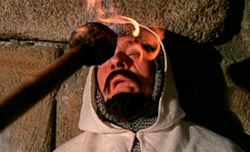
 Once upon a time, aspiring filmmakers wanted to make movies. Today, it seems they only want to make one kind: the slasher film. That would be fine if the young pups came equipped with a new twist to offer; barring that, I’d settle for capable execution (no pun intended). In Scream Park, neophyte writer/director/producer Cary Hill obviously has the subgenre’s recipe in pocket, but doesn’t necessarily pay attention to the proper amount of ingredients. Therefore, it comes out of the oven hardly resembling what it was intended to honor.
Once upon a time, aspiring filmmakers wanted to make movies. Today, it seems they only want to make one kind: the slasher film. That would be fine if the young pups came equipped with a new twist to offer; barring that, I’d settle for capable execution (no pun intended). In Scream Park, neophyte writer/director/producer Cary Hill obviously has the subgenre’s recipe in pocket, but doesn’t necessarily pay attention to the proper amount of ingredients. Therefore, it comes out of the oven hardly resembling what it was intended to honor.
Due to dwindling (read: nonexistent) attendance, the Fright Land theme park has filed for bankruptcy and is going out of business. On its final night, the high schoolers who work there conspire to hold an after-hours liquor party, with their butt-cut-haired manager (Steve Rudzinski, Everyone Must Die!) supervising. Making their young lives miserable are a killer in a raggedy burlap-sack mask and a killer in a more fashionable creepy-bird mask. It’s the former, however, who is more creative, what with shoving the post-coital girl’s face into the boiling grease of a deep fryer. No more fries for you, hon!
 And no fun for us! With an actual amusement park in Pennsylvania as his setting, Hill makes good use of the merry-go-round, roller coaster, haunted house, etc. in the various kills, and poor use of Doug Bradley, the Hellraiser series‘ Pinhead, who cameos as the park owner who proposes a tough-to-swallow solution for turning his business around. It’s even too incredulous to ask of an audience — even one just waiting for the next onscreen slaying.
And no fun for us! With an actual amusement park in Pennsylvania as his setting, Hill makes good use of the merry-go-round, roller coaster, haunted house, etc. in the various kills, and poor use of Doug Bradley, the Hellraiser series‘ Pinhead, who cameos as the park owner who proposes a tough-to-swallow solution for turning his business around. It’s even too incredulous to ask of an audience — even one just waiting for the next onscreen slaying.
Those grisly scenes are pulled off without any panache. Free of scares or suspense, Scream Park is flat and ponderous, with some sleepy performances to match. As is the case with the majority of low- to no-budget slasher homages these days — hitting DVD within a few months’ time frame were the near-interchangeable HazMat, Murder University, Bloody Homecoming, Sorority Party Massacre and the very similar Killer Holiday — the order of the day is wasted creative force: no imagination, all imitation. That, to me, is depressing. —Rod Lott


 Even compared to Al Adamson’s other cheap films,
Even compared to Al Adamson’s other cheap films, 



 With their previous movies, Jason Friedberg and Aaron Seltzer have set the bar so low for themselves — if not film comedy in general — that all
With their previous movies, Jason Friedberg and Aaron Seltzer have set the bar so low for themselves — if not film comedy in general — that all 

